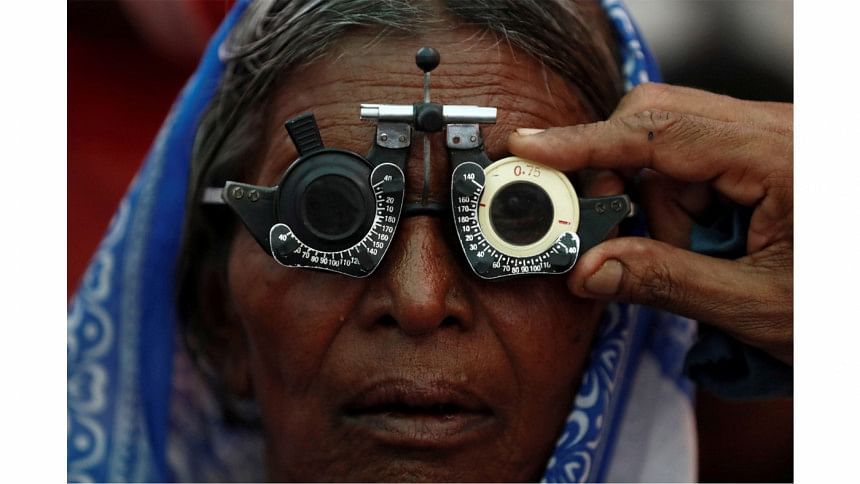Stop diabetic retinopathy before it starts

With around 10 million diagnosed patients, Bangladesh remains at the forefront of the global diabetes epidemic, where one out of every ten adults is diabetic, according to 2017 data from the International Diabetes Federation. Diabetes mellitus is a group of metabolic disorders sharing the common feature of hyperglycaemia or high blood sugar. Long-standing hyperglycaemia, or in other words, uncontrolled diabetes, is associated with multiple organ damage such as eyes, kidneys and nerves, and triggers diseases like diabetic retinopathy, diabetic nephropathy and diabetic neuropathy, respectively.
Diabetic retinopathy is among the earliest complications of uncontrolled diabetes. It is a clinical condition characterised by the damage of the retinal blood vessels due to high blood sugar levels. Its typical features include abnormal blood vessel growth, aneurysm, haemorrhage and accumulation of hard exudates in the retina. Almost all diabetic patients develop retinopathy within five to 15 years of the onset of diabetes; however, individuals with long-standing and uncontrolled diabetes are more likely to develop the disease. Globally, diabetic retinopathy is one of the leading causes of visual impairment and blindness. In 2011, 126.6 million adults worldwide lived with diabetic retinopathy, which will grow to 191.0 million by 2030 if the current trend continues. Remarkably, the burden of both diabetes and diabetic retinopathy is disproportionately high in the developing countries of Asia and Africa.
Like other developing countries, Bangladesh is confronting the rising burden of diabetes and its associated complications, including diabetic retinopathy. In 2020, the country was home to around 1.85 million diabetic retinopathy patients, according to the International Agency for the Prevention of Blindness. According to recently published studies, one to three out of every ten diabetic patients in Bangladesh suffer from this progressive eye disease. In spite of being widely prevalent among diabetic patients, diabetic retinopathy is more common in individuals with uncontrolled diabetes, obesity and high blood pressure. This prevalence also increases with increasing age and duration of diabetes. Physical inactivity, tobacco consumption and elevated serum cholesterol further increase the risk of retinopathy among diabetic patients.
Diabetic retinopathy is an incurable disease; however, the disease progression can be halted by early diagnosis and treatment. Despite being an important public health concern, diagnosis and management of diabetic retinopathy receive minimal attention from patients in Bangladesh. Here, diabetic patients are advised to perform retinal examination immediately after diagnosing diabetes and then once a year, irrespective of age. However, diabetic patients often fail to comply with this advice and delay in seeking care mainly due to a lack of awareness about the consequences of diabetic retinopathy (sudden onset of bleeding and blindness) and financial constraints. In addition, retinal examination facilities are highly concentrated in urban areas, where patients can avail this service at tertiary level health facilities, private hospitals and private practitioners. However, in rural and remote areas, lack of trained healthcare providers and unavailability of necessary equipment (like fundoscopy machines) contribute to delayed diagnosis.
For chronic disease management, counselling plays a crucial role, particularly in motivating patients to comply with healthcare advice and regular follow-up. Nevertheless, in Bangladesh, physicians often encounter a heavy workload and thus get less time for counselling patients. Inadequate counselling subsequently contributes to delayed care-seeking and irregular follow-up for diabetic retinopathy. As a result, it is diagnosed at an advanced stage for many patients, sometimes when the disease gets far too complicated (macular oedema, haemorrhage, narrow visual field). Poor diabetes control and delayed initiation of treatment also hasten the disease progression, and many patients even visit physicians after the sudden onset of blindness.
As diabetic retinopathy is one of the leading causes of blindness and disability among diabetic patients and could be prevented through early detection, a non-invasive screening tool could play a critical role in this regard, especially in a resource-poor country like Bangladesh, where early detection is hampered due to inadequate human resources and necessary equipment. This kind of tool has been identified as an efficient and cost-effective means of screening diabetes-induced retinopathy in countries like the UK, Iran and China. Keeping this in mind, BRAC James P Grant School of Public Health, in collaboration with The Fred Hollows Foundation in Australia, Diabetic Association of Bangladesh and BIRDEM Hospital, will be developing and validating a simple, questionnaire-based risk stratification tool for diabetic retinopathy screening—the first of its kind in Bangladesh. The expectations arez that the tool will enable Bangladeshi physicians, especially those providing care in rural and remote areas, to identify individuals at high risk of developing diabetic retinopathy at an early stage and thus, prevent the blindness and disability associated with this disease.
While diabetic retinopathy is a progressive disease like cataract and glaucoma, early diagnosis and treatment can halt its progression. As it is an incurable disease and its treatment is expensive, especially in a country like Bangladesh, where universal health coverage has not been achieved and out-of-pocket expenditure is the primary source of healthcare finance, a collaborative approach for prevention, early detection and timely management of diabetic retinopathy is warranted to combat the burden of this overlooked disease in Bangladesh.
Dr Ipsita Sutradhar is senior research fellow, at the Centre for Non-communicable Diseases & Nutrition (CNCDN) and Centre of Excellence for Science of Implementation and Scale Up (CoE-SISU), in BRAC James P Grant School of Public Health, BRAC University.

 For all latest news, follow The Daily Star's Google News channel.
For all latest news, follow The Daily Star's Google News channel. 


Comments